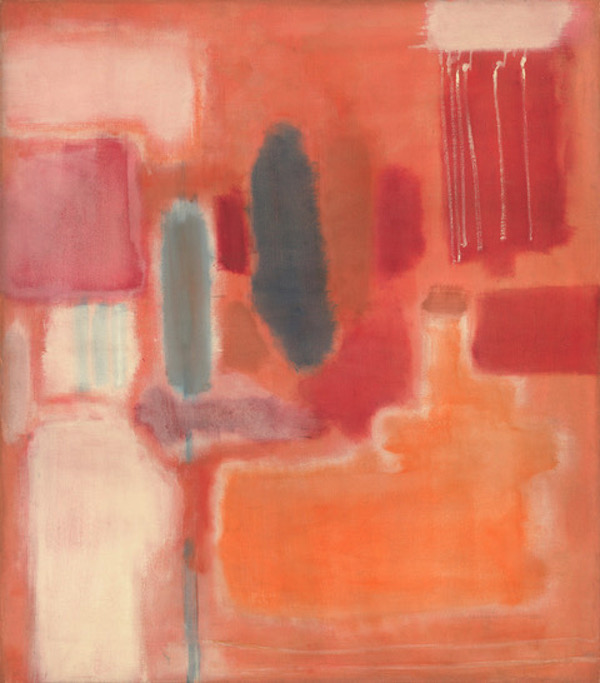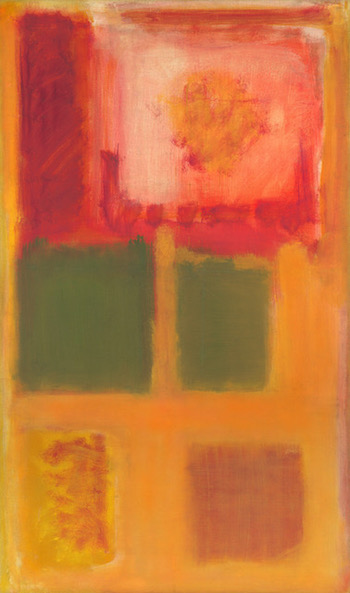Visual Arts Review: Prince of Pieces — Rothko at the MFA
There are no angels in Mark Rothko’s work: only the ascendancy of glorious color.
Mark Rothko: Reflection, John F. Cogan, Jr. and Mary L. Cornille Gallery (Gallery 260), Museum of Fine Arts Boston, through September 3.

No. 9, Mark Rothko, 1948, Oil and mixed media on canvas © 1998 Kate Rothko Prizel & Christopher Rothko / Artists Rights Society (ARS), New York Courtesy National Gallery of Art and the Museum of Fine Arts, Boston.
By Peter Walsh
When the loose coalition of artists, later known as the “New York School,” began to assemble in cheap apartments, lofts, and bars in lower Manhattan, its membership read like the cast of a World War II combat movie. There was the cowboy from Wyoming (Jackson Pollock), the Armenian war refugee (Arshile Gorky), the former Midwestern auto worker (David Smith), the pampered San Francisco aristocrat (Robert Motherwell), the illegal Dutch immigrant (Willem de Kooning), and the tough-as-nails broad from Brooklyn (Lee Krasner).
Perhaps the least likely of the bunch was Mark Rothko. A one-time Talmudic student born on the Baltic edge of the Russian Empire and an immigrant high school honors student from Portland with a strong interest in left-wing politics and a gift for oratory, Rothko spent several semesters at Yale. He had seemed destined to begin a career as an academic, public intellectual, or union organizer. But, losing his scholarship, Rothko dropped out of college. He drifted into the obscure avant-garde circles of the bustling commercial city that became his home.
At the time, no modernist American artist had an expectation of earning a living from his work. Rothko’s Jewish middle-class family, observing aghast from Depression Era Portland, could only assume he had taken leave of his senses.
The eleven canvases in the MFA’s Mark Rothko: Reflections provide a quick but satisfying introduction to the Rothko who became one of the nation’s leading 20th-century artists.Click To Tweet The canvases on view are mostly large scale, brilliantly colored abstract works in Rothko’s iconic, mature style. But the exhibition includes enough—barely—to illustrate his long path to that destination. Like most of the Abstract Expressionists, Rothko only arrived after wandering for years in modernist figural styles, exploring the European avant-garde movements of Cubism and Surrealism, looking for an authentic and American style.At its beginning, the show’s curators match Rothko’s Thru the Window (1938-39), the earliest Rothko in the show, with Rembrandt’s celebrated spiritual self-portrait Artist in His Studio, from the MFA collection. But, unlike the confident Rembrandt figure, the cartoonish Rothko, looking oddly like the poster image for the film Eraserhead, never quite enters the room. Instead, he lingers outside at a window, looking wistfully toward a model and away from his easel, pressed awkwardly against the wall. There is a certain doubtfulness about the whole enterprise, as if family warnings are still ringing in the artist’s ears.
Although he was deeply inspired by his mentor, Milton Avery, who had reduced the human form to contrasting shapes of bright color, Rothko eventually decided that figural painting did not work for him. Two so-called multiforms, No. 9 and No. 10, from a brief transitional period in the late 1940s, show Rothko pulling away from surrealist imagery for good. In these two paintings, hazy darker shapes—they might be human beings or paintings on the wall, a rug, window, or a corner of a room—hover suggestively on bright red and yellow backgrounds.

No. 10, Mark Rothko, 1949, Oil on canvas © 1998 Kate Rothko Prizel & Christopher Rothko / Artists Rights Society (ARS), New York Courtesy National Gallery of Art and Museum of Fine Arts, Boston.
Four “classic works”—untitled pieces from 1949 and 1955, Mulberry and Brown (1958), and No. 1 (1961)—represent the most recognizable Rothko imagery of the 1950s and early 60s. Mulberry and Brown is the most profoundly Rothko—a huge dark rectangle looms over a somber yet richly modulated maroon ground, as if representing the existential dilemmas of the Atomic Age.
The show concludes with examples from a 1964 series of “black paintings,” large-scale works that at first seem entirely blank and featureless. Only gradually do the haunting rectangles emerge from the inert, lightless ground, like a Zen satori. These works led up to Rothko’s most famous composition: the so-called Rothko Chapel in Houston, Texas, a carefully related abstract series of fourteen works commissioned by John and Dominique de Menil. The effort to create these monumental images finished the artist. In 1970, ill and deeply depressed, despite (or, some say, because of) his growing fame and financial success, Rothko committed suicide. He never saw the chapel completed.
Rothko’s later work, especially the de Menil series in Houston, are much admired for their perceived meditative qualities. Some regard them as at least as deeply religious as the church paintings of the Renaissance. The late critic Robert Hughes was a skeptic. “[Rothko’s] mature paintings could be ravishingly beautiful, in their depth and relationships of color,” he wrote, “in their trust that Rothko’s own abandonment of feeling could evoke an equal letting go in the viewer. . . . Their emotional range is wide. . . . But was this enough to constitute a major religious experience? One can only answer, without skepticism, that it was not. . . . [The] expected epiphany does not come.”
But could there be a better expression of late 20th-century religious sensibilities, in the era of The God That Failed, Waiting for Godot, and On the Beach? The time when American positivism faded into uncertainty and monochrome TV images only dimly glimpsed through darkened living rooms? There are no angels in Rothko’s work: only the ascendancy of glorious color. They herald that final revelation that will never arrive.
Peter Walsh has worked as a staff member or consultant to such museums as the Harvard Art Museums, the Museum of Fine Arts, Boston, the Davis Museum at Wellesley College, The Metropolitan Museum of Art, the National Gallery of Art, and the Boston Athenaeum. As an art historian and media scholar, he has lectured in Boston, New York, Chicago, Toronto, San Francisco, London, and Milan, among other cities and has presented papers at MIT eight times. He has published in American and European newspapers, journals, and in anthologies. In recent years, he began a career as an actor and has since worked on more than eighty projects, including theater, national television, and such award-winning films as Spotlight, The Second Life, and Brute Sanity. He is a graduate of Oberlin College and Harvard University.

Rothko’s paintings are dazzling. While on a primary school field trip to the Albright-Knox Art Gallery in Buffalo, NY I saw Rothko’s “Orange and Yellow”, 1956. I still remember the impact it made on me that day, the ethereal lively color of the painting in contrast to the gray light of Buffalo winter days certainly warmed me throughout.